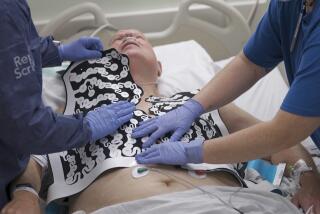Heart Treatment Rejected in ‘60s Gets a New Look
- Share via
A simple, inexpensive heart attack treatment that could be used successfully by low technology hospitals worldwide can dramatically reduce the number of deaths caused by heart attacks, researchers reported today.
In the United States, the treatment, which involves giving the patient a mixture of sugar, insulin and potassium to nourish heart muscles deprived of oxygen by a heart attack, might prevent about 75,000 heart-attack deaths a year, the new research indicates.
Ironically, the treatment was devised in the 1960s, but was discarded because poorly conducted clinical tests led doctors to doubt that it worked.
But a new study by a team of researchers from six Latin American countries reported in Circulation: Journal of the American Heart Assn., indicates that the earlier doubts were ill-founded.
In a pilot trial involving 407 people who had heart attacks, the use of the treatment, called GIK--for glucose, insulin and potassium (for which K is the chemical symbol)--reduced the overall death rate by half.
In patients who either received a clot-busting drug or underwent angioplasty to open clogged arteries, the use of GIK reduced the death rate from 15.2% to 5.2%.
An estimated 1.1 million Americans have a heart attack each year and about a third of them die.
The trial is “a landmark study,” said Dr. Carl S. Apstein of the Boston University School of Medicine. “The decrease in death rate is dramatic, the largest reduction of just about any intervention that has been tried.”
“The thing that makes it potentially very important is the rather astounding positive beneficial effect it had in reducing death rates after a heart attack,” said Dr. Timothy Gardner of the University of Pennsylvania School of Medicine. “When we talk about [clot-busting] agents, we say a 10% improvement is really notable. This says we can get up to a 40% improvement if a simple, inexpensive treatment is used routinely.”
Equally important, “this is something that could be used in any community hospital around the world,” added Gardner, who is chairman of the American Heart Assn.’s Council on Cardiothoracic Surgery.
The treatment was first reported in 1962 as a way to provide energy for the heart muscle during and immediately after a heart attack, when some tissue is not receiving oxygen because of reduced blood flow. Glucose can be used by heart tissue without oxygen. Insulin and potassium increase the muscle’s ability to take up the glucose.
The combination also reduces the harmful high concentrations of free fatty acids that are present during the acute phase of a heart attack.
For a decade, some physicians continued to use the treatment, but clinical studies came to conflicting conclusions about its effectiveness.
Some researchers continued to study its use in animals, and “it very consistently showed a protective effect,” Apstein said. “So there was this disparity for 25 or 30 years between what was shown to work in animals and what was never shown to work in patients.”
Last year, Apstein reviewed the earlier studies in humans, throwing out those that were poorly designed or that used doses of GIK that were demonstrably too small. Combining the remaining studies, he concluded that the treatment was most likely beneficial and recommended a large-scale trial.
But a group of Latin American physicians, the ECLA (Estudios Cardiologicos Latinoamerica) Collaborative Group, had already organized such a trial in six countries: Argentina, Brazil, Chile, Mexico, Uruguay and Venezuela. It is the ECLA results that are being reported today.
Critics and the researchers caution that the number of patients in the study is relatively small. “So instead of looking for the magnitude of the benefit, we should be looking for the direction of the benefit,” said the study leader, Dr. Rafael Diaz of the Istituto Cardiovascular de Rosario in Argentina. “And the direction of the benefit is consistently positive.”
They also cautioned that the study was not “blinded,” so physicians knew which patients were receiving the treatment. It is possible, therefore, that physicians unconsciously gave the treatment to patients they thought more likely to survive, and those patients might have inadvertently received better care.
The only side effect of the treatment was a mild case of phlebitis at the site where the medication was injected. Phlebitis is characterized by stiffness, inflammation or pain occurring when a vein is punctured.
To overcome the criticisms of the current trial, Diaz and his colleagues are organizing a larger trial that will involve 10,000 heart attack patients at 400 centers throughout the world, including the United States.
“We are expecting a reduction in death of about 15% or 20% among patients treated with GIK,” Diaz said. Nobody can expect a reduction of more than 20% or 25%, because heart attack is a very prevalent disease with high rates of mortality.”
The new study is expected to conclude in 2001.
The latest science news is always available on The Times’ Web site: https://www.latimes.com/science






